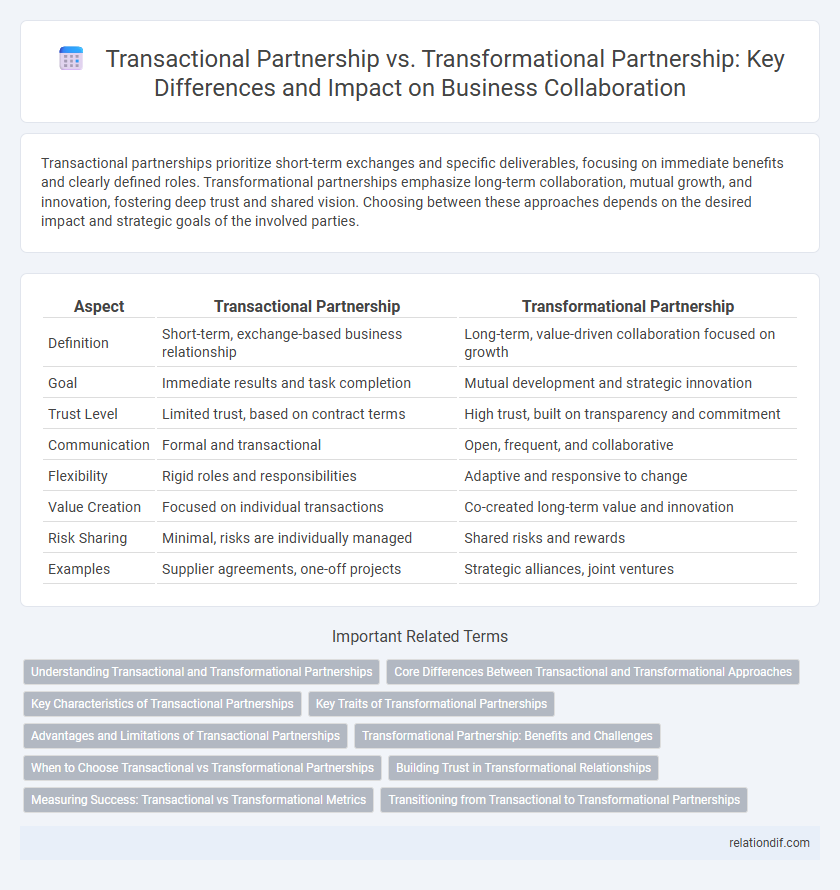Transactional partnerships prioritize short-term exchanges and specific deliverables, focusing on immediate benefits and clearly defined roles. Transformational partnerships emphasize long-term collaboration, mutual growth, and innovation, fostering deep trust and shared vision. Choosing between these approaches depends on the desired impact and strategic goals of the involved parties.
Table of Comparison
| Aspect | Transactional Partnership | Transformational Partnership |
|---|---|---|
| Definition | Short-term, exchange-based business relationship | Long-term, value-driven collaboration focused on growth |
| Goal | Immediate results and task completion | Mutual development and strategic innovation |
| Trust Level | Limited trust, based on contract terms | High trust, built on transparency and commitment |
| Communication | Formal and transactional | Open, frequent, and collaborative |
| Flexibility | Rigid roles and responsibilities | Adaptive and responsive to change |
| Value Creation | Focused on individual transactions | Co-created long-term value and innovation |
| Risk Sharing | Minimal, risks are individually managed | Shared risks and rewards |
| Examples | Supplier agreements, one-off projects | Strategic alliances, joint ventures |
Understanding Transactional and Transformational Partnerships
Transactional partnerships focus on specific, short-term exchanges where each party aims to maximize immediate benefits, often based on contract terms and clear deliverables. Transformational partnerships emphasize long-term collaboration, innovation, and mutual growth, fostering trust and shared goals that extend beyond individual transactions. Understanding these differences helps businesses choose the right approach for sustaining competitive advantage and driving strategic value.
Core Differences Between Transactional and Transformational Approaches
Transactional partnerships focus on specific, short-term exchanges driven by clearly defined deliverables and immediate benefits, typically emphasizing cost efficiency and contractual obligations. Transformational partnerships prioritize long-term relationships, fostering innovation, mutual growth, and adaptability by aligning shared visions and values. Core differences lie in the depth of collaboration, with transactional partnerships emphasizing rigid, performance-based interactions while transformational ones encourage strategic, evolving engagement and trust-building.
Key Characteristics of Transactional Partnerships
Transactional partnerships prioritize short-term goals with clear, specific exchanges focusing on immediate benefits. These partnerships emphasize formal agreements, defined roles, and measurable outcomes, often driven by cost-efficiency and risk reduction. Trust in transactional partnerships is typically limited to contractual obligations rather than deeper collaboration or shared vision.
Key Traits of Transformational Partnerships
Transformational partnerships are characterized by deep trust, shared vision, and mutual commitment to long-term growth, transcending mere transactional exchanges. These partnerships emphasize collaboration, innovation, and adaptability, enabling partners to co-create value and drive significant change. Unlike transactional partnerships focused on short-term goals, transformational partnerships foster continuous improvement and strategic alignment across all levels.
Advantages and Limitations of Transactional Partnerships
Transactional partnerships offer clear advantages such as straightforward agreements, well-defined roles, and predictable outcomes, facilitating efficient short-term goal achievement. However, their limitations include a lack of deep collaboration, reduced innovation potential, and vulnerability to market fluctuations due to limited strategic alignment. These partnerships often prioritize immediate gains over long-term growth, restricting scalability and mutual value creation.
Transformational Partnership: Benefits and Challenges
Transformational partnerships drive long-term value creation by fostering innovation, strategic alignment, and deep collaboration beyond transactional exchanges. Benefits include enhanced competitive advantage, shared risk management, and co-developed solutions tailored to evolving market demands. Challenges involve navigating cultural differences, maintaining trust, and aligning goals amidst dynamic business environments.
When to Choose Transactional vs Transformational Partnerships
Transactional partnerships are ideal for short-term, specific tasks where clear deliverables and immediate results are required, such as vendor agreements or outsourcing services. Transformational partnerships suit long-term collaborations focused on innovation, growth, and strategic alignment, where both parties invest in shared vision and co-creation. Choosing between them depends on organizational goals, time horizon, resource commitment, and the desired impact on business evolution.
Building Trust in Transformational Relationships
Building trust in transformational partnerships requires consistent transparency, open communication, and a shared commitment to long-term goals that transcend immediate transactional gains. Trust is cultivated through collaborative problem-solving, mutual respect, and a deep understanding of each partner's values and vision. This foundation enables adaptive strategies and innovative growth, distinguishing transformational relationships from merely transactional interactions.
Measuring Success: Transactional vs Transformational Metrics
Measuring success in transactional partnerships primarily relies on quantitative metrics such as sales volume, cost savings, and contract compliance. Transformational partnerships focus on qualitative outcomes like innovation impact, shared value creation, and long-term strategic alignment. Evaluating both types requires distinct KPIs that reflect immediate deliverables for transactional relationships and progressive growth indicators for transformational collaborations.
Transitioning from Transactional to Transformational Partnerships
Transitioning from transactional to transformational partnerships requires shifting focus from short-term exchanges to long-term value creation through trust, collaboration, and innovation. Organizations must invest in deepening relationships by aligning goals, sharing risks, and co-developing solutions that drive mutual growth. This strategic evolution enhances competitive advantage and fosters sustainable business ecosystems.
Transactional Partnership vs Transformational Partnership Infographic

 relationdif.com
relationdif.com